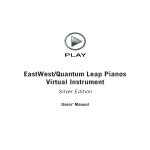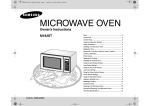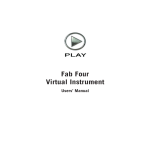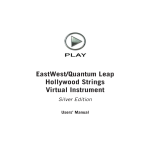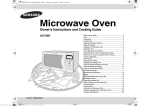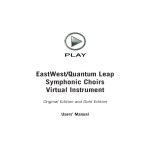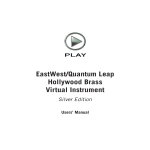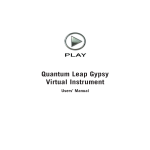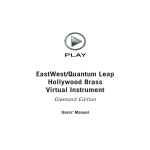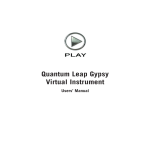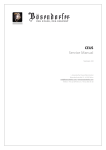Download Quantum Leap Pianos Virtual Instrument Manual
Transcript
EastWest/Quantum Leap Pianos Virtual Instrument Users’ Manual EASTWEST/QUANTUM LEAP PIANOS VIRTUAL INSTRUMENT The information in this document is subject to change without notice and does not represent a commitment on the part of East West Sounds, Inc. The software and sounds described in this document are subject to License Agreements and may not be copied to other media. No part of this publication may be copied, reproduced or otherwise transmitted or recorded, for any purpose, without prior written permission by East West Sounds, Inc. All product and company names are ™ or ® trademarks of their respective owners. © East West Sounds, Inc., 2007. All rights reserved. East West Sounds, Inc. 6000 Sunset Blvd. Hollywood, CA 90028 USA 1-323-957-6969 voice 1-323-957-6966 fax For questions about licensing of products: [email protected] For more general information about products: [email protected] http://support.soundsonline.com ii EASTWEST/QUANTUM LEAP PIANOS VIRTUAL INSTRUMENT 1. Welcome 2 3 5 6 7 8 About EastWest Producer: Doug Rogers Producer: Nick Phoenix Credits How to Use This and the Other Manuals Online Documentation and Other Resources Click on this text to open the Master Navigation Document 1 EASTWEST/QUANTUM LEAP PIANOS VIRTUAL INSTRUMENT Welcome About EastWest EastWest (www.soundsonline.com) has been dedicated to perpetual innovation and uncompromising quality, setting the industry standard as the most critically acclaimed producer of Sample CDs and Virtual (software) Instruments. Founder and producer Doug Rogers has over 30 years experience in the audio industry and is the recipient of many recording industry awards including “Recording Engineer of the Year.” In 2005, “The Art of Digital Music” named him one of “56 Visionary Artists & Insiders” in the book of the same name. In 1988, he founded EastWest, the most critically acclaimed sound developer in the world, and recipient of over 50 industry awards, more than any other sound developer. His uncompromising approach to quality, and innovative ideas have enabled EastWest to lead the sound-ware business for 20 years. In 1997 Rogers partnered with producer/composer Nick Phoenix and set up Quantum Leap, a wholly owned division of EastWest, to produce high-quality, no-compromise sample libraries and virtual instruments. Quantum Leap virtual instruments are mostly produced by Nick Phoenix. Some of the larger productions, such as Symphonic Orchestra, Symphonic Choirs and Quantum Leap Pianos are co-produced by Doug Rogers and Nick Phoenix. As a composer, Phoenix began scoring film trailers and television commercials in 1994. To date, he has either scored or licensed music for the ad campaigns of over 1000 major motion pictures including Tomb Raider 2, Terminator 3, Lord of the Rings Return of the King, Harry Potter 2, Star Wars Episode 2, Spiderman 3, Pirates of the Caribbean 3, Blood Diamond, Night at the Museum, and The Da Vinci Code. Quantum Leap has now firmly established itself as one of the world’s top producers of high-end sample libraries and virtual instruments. In 2006, EastWest purchased the legendary Cello Studios (formerly United Western Recorders) on Sunset Boulevard in Hollywood, re-naming it EastWest Studios. The 21,000 sq. ft. facility, since remodelled by master designer Philippe Starck, houses five recording studios and is the world headquarters for EastWest. Chapter 1: Welcome 2 EASTWEST/QUANTUM LEAP PIANOS VIRTUAL INSTRUMENT Producer: Doug Rogers Doug Rogers has over 30 years experience in the audio industry and is the recipient of many recording industry awards including “Recording Engineer of the Year.” In 2005, “The Art of Digital Music” named him one of “56 Visionary Artists & Insiders” in the book of the same name. In 1988, he founded EastWest, the most critically acclaimed sound developer in the world, and recipient of over 50 industry awards, more than any other sound developer. His uncompromising approach to quality, and innovative ideas have enabled EastWest to lead the sound-ware business for 20 years. In the late eighties, he released the very first commercial drum sample CD, and followed it with the multiple-award-winning “Bob Clearmountain Drums” sample collection. In the years that followed he practically reinvented the sound-ware industry. EastWest introduced loop sample libraries to the market in the early nineties, followed closely by the first midi-driven loops (Dance/Industrial). He released the first sample library to include multiple dynamics, followed by the first sample library to stream from hard disk, an innovation that led to the detailed collections available today. His recent productions of Symphonic Orchestra (awarded a Keyboard Magazine “Key Buy Award,” EQ Magazine “Exceptional Quality Award,” Computer Music Magazine “Performance Award,” and G.A.N.G. [Game Audio Network Guild] “Best Sound Library Award”); and Symphonic Choirs (awarded Electronic Musician “2006 Editor’s Choice Award,” G.A.N.G. “Best Chapter 1: Welcome 3 EASTWEST/QUANTUM LEAP PIANOS VIRTUAL INSTRUMENT Sound Library Award,” and Keyboard Magazine “Key Buy Award”). He persuaded audio legend Prof. Keith O. Johnson to record EWQLSO and EWQLSC, and came up with the revolutionary idea of recording all instruments and voices with 3 simultaneous stereo mic setups so users can control the tone of the performances and the acoustics of the concert hall, as well as create surround sound mixes. His latest productions include Quantum Leap Pianos, another 3 mic setup, and the most detailed virtual piano collection ever produced; and Fab Four, inspired by the sounds of the Beatles, featuring the same kind of vintage instruments and original EMI/Abbey Road recording equipment as the Beatles used to create their music. He persuaded audio legend Ken Scott, who was involved in the recording of five Beatles albums, and engineer for “Magical Mystery Tour” and “The Beatles” (also known as the White Album) to work with him on Fab Four. He also acquired one of Hollywood’s most famous recording studio complexes in 2006, formally United Western (now EastWest Studios), recipient of more engineering awards and RIAA certified Gold and Platinum recordings than any other studios worldwide. He persuaded top international design superstar Philippe Starck to redesign the non-technical areas of the studios. Over the last decade he has partnered with producer/composer Nick Phoenix and set up the Quantum Leap imprint, a subsidiary of EastWest, to produce high-quality, no compromise sample libraries and virtual instruments. EastWest/ Quantum Leap virtual instruments are considered the best available and are in daily use by the who’s who of the industry. His latest technical achievement was unveiled at the 2007 NAMM convention - the world’s first 64-bit audio engine named PLAY, which powers EastWest/Quantum Leap’s latest suite of virtual (software) instruments. Chapter 1: Welcome 4 EASTWEST/QUANTUM LEAP PIANOS VIRTUAL INSTRUMENT Producer: Nick Phoenix Nick began scoring film trailers and television commercials in 1994. To date, he has either scored or licensed music for the ad campaigns of over 1000 major motion pictures. “Rendition,” “Spider-Man 3,” “Golden Compass.” “The Assassination of Jesse James,” “Pirates of the Caribbean 3,” “Babel,” “Hitman,” “I Am Legend,” “300,” “No Country For Old Men,” “Harry Potter 5,” “The Brave One,” “Wall-E,” “Blood Diamond,” “Speed Racer,” and “Night at the Museum” are a few recent examples. Nick and Thomas Bergersen founded the ultimate trailer music company “Two Steps From Hell” in 2006. www. twostepsfromhell.com. Nick has also scored numerous TV shows for NBC, CBS, Showtime, and Fox. “In Pot We Trust,” a Showtime original film, is playing in the fall of 2007. The journey as a composer has also inspired Nick to record and program his own sounds and samples. Nick founded Quantum Leap Productions in 1997 and Quantum Leap has since grown to be the world’s top producer of high-end virtual instruments. A 10‑year partnership with Doug Rogers and East West has yielded countless award winning software titles such as Stormdrum, Symphonic Orchestra, Symphonic Choirs, RA, Voices of Passion, Ministry of Rock, Gypsy, QL Pianos, VOTA, QL Brass, QL Guitar and Bass, Hardcore Bass, Goliath, and Colossus. Nick’s studio is located in Venice, California, and is 100% solar powered. www.nickphoenix.com Chapter 1: Welcome 5 EASTWEST/QUANTUM LEAP PIANOS VIRTUAL INSTRUMENT Credits Producers Nick Phoenix, Doug Rogers Engineering Doug Rogers, Nick Phoenix, Ken Scott (Bechstein close mics) Engineering Assistants Rhys Moody, Beau Fletcher Piano Player John Sawoski Programming Nick Phoenix, Justin Harris, Mike Dimattia Sound Editing Justin Harris, Mike Dimattia, Alec Phoenix, Nick Phoenix, Carlos Vasquez, Aldo Lehman, Brendan Ballintine Art Direction Doug Rogers, Nick Phoenix, Steven Gilmore, Thomas Merkle Software Doug Rogers, Nick Phoenix, Klaus Voltmer, Klaus Lebkucher, Patrick Stinson, Stefan Kersten, Toine Diepstraten, Sam Fischmann, Nick Cardinal, David Kendall Manual John Philpit Chapter 1: Welcome 6 EASTWEST/QUANTUM LEAP PIANOS VIRTUAL INSTRUMENT How to Use This and the Other Manuals All documentation for the EastWest PLAY Advanced Sample System and its libraries is provided as a collection of Adobe Acrobat files, also called PDFs. They can be viewed on the computer screen or printed to paper. Each time you install one of the PLAY System libraries, two manuals are copied to the file system on your computer: • The manual that describes the whole PLAY System. The largest of the manuals, it addresses how to install and use all aspects of the software that are common to all libraries. • The library-specific manual, such as the one you are currently reading. This smaller document describes aspects that differ from one library to the next, such as the list of included instruments and articulations. Using the Adobe Acrobat Features By opening the Bookmarks pane along the left edge of the Adobe Acrobat Reader, the user can jump directly to a topic from the section names. Note that some older versions of Acrobat Reader might not support all these features. The latest Acrobat Reader can be downloaded and installed at no cost from the Adobe web site. (As an example of a hyperlink, you can click on the last word of the previous sentence to be taken directly to the Adobe site.) When reading this and other manuals on the computer screen, you can zoom in to see more detail in the images or zoom out to see more of the page at once. If an included picture of the user interface, or a diagram, seems fuzzy or illegible, then zoom in using one of several means provided in the Acrobat Reader software. The Master Navigation Document Because the EastWest PLAY System is a collection of components, each with its own User’s Manual, a Master Navigation Document (MND) is provided to allow users to jump quickly between these PDFs when being read on the computer screen. This MND is a one-page file with hyperlinks to the PLAY System documentation and to all the library manuals. Hyperlinks to this Master Navigation Document are found on the title page of each chapter in each document. From there, you can open any other document in the collection. For example, if you’re reading something in this documentation for the Quantum Leap Pianos library, and need to open the manual for the PLAY System as well, go to any chapter title page and click on the link that says, “Click on this text to open the Master Navigation Document.” It will open in a new window on the screen. In that document, click on the icon for the PLAY System and its manual will open in the same window (hiding the MND). You now have both the QLP library manual and the PLAY System manual open in separate windows so you can refer to them both. Chapter 1: Welcome 7 EASTWEST/QUANTUM LEAP PIANOS VIRTUAL INSTRUMENT Online Documentation and Other Resources For the most up to date information, visit the support pages at EastWest’s web site. There you can find: • information made available after these manuals were written • FAQ pages that may already list answers to questions you have • suggestions from EastWest and other users of the EastWest PLAY System • news about upcoming releases The address is: http://support.soundsonline.com You can also visit the EastWest online forums. There you can read comments and questions from others who use EastWest products and post your own. The many forum participants are a good source of helpful information about both the technical and musical aspects of this software. The address of the forums is: http://www.soundsonline-forums.com Chapter 1: Welcome 8 EASTWEST/QUANTUM LEAP PIANOS VIRTUAL INSTRUMENT 2. EastWest/Quantum Leap Pianos, An Overview 10 12 12 14 The Design Point for the Quantum Leap Pianos Library What’s Included Notes from the Producer Hardware Requirements Click on this text to open the Master Navigation Document 9 EASTWEST/QUANTUM LEAP PIANOS VIRTUAL INSTRUMENT EastWest/Quantum Leap Pianos, An Overview EastWest/Quantum Leap Pianos was produced by Doug Rogers and Nick Phoenix, the same production team that produced the multi-award winning EastWest/Quantum Leap Symphonic Orchestra and EastWest/Quantum Leap Symphonic Choirs. Individually, these producers have also produced all of the Quantum Leap and most of the EastWest sample libraries and virtual instruments. The Design Point For the EastWest/Quantum Leap Pianos Library The goal was to create virtual pianos that more closely resembled real pianos than the virtual pianos that are currently available. The finished product was matched against the real pianos that were sampled extensively. The producers were able to do this because they own all of the pianos that were sampled. The 3 mic positions were recorded (close mics, player position mics and room mics), similar to EastWest/Quantum Leap Symphonic Orchestra and EastWest/Quantum Leap Symphonic Choirs. The four pianos were also sampled with unprecedented dynamic range, release trails, and the following seven articulations: • sustain, with and without the sustain pedal • soft pedal, with and without the sustain pedal • 180 bpm true repetition, with and without the sustain pedal • 180 bpm staccato The custom designed PLAY-powered interface includes a mixer to control the mics, the lid position, the articulations, concert hall impulse reverb, and many other aspects of the pianos. The signal chain used to record the pianos is a combination of classic warm tube equipment (mics), classic analogue solid state circuitry (console), and modern pristine digital equipment (converters). The close mics were AKG C12A’s, the player position mics were Neumann U67’s, and the room mics were Neumann M50’s. A custom Neve 8078 console was used with Meitner converters. Three of the pianos (Bechstein, Bösendorfer and Steinway) were recorded in EASTWEST studio 1 (formerly United/Western Studio 1, see the history online in the main PLAY System manual). This studio is large enough to record an orchestra (see picture below), and is famous for its acoustics which are very similar to a Hollywood soundstage or orchestral stage. This type of sound works better with digital or convolution reverb than dry samples. The EastWest/Quantum Leap Pianos Virtual Instrument includes impulses of the concert hall where EastWest/ Quantum Leap Symphonic Orchestra was recorded. This convolution reverb, paired with these pianos, is pure magic. It also makes the pianos very compatible with EWQLSO. The fourth piano (Yamaha C7) was recorded in EastWest’s famous “rock” studio 2. Chapter 2: EastWest/Quantum Leap Pianos, An Overview 10 EASTWEST/QUANTUM LEAP PIANOS VIRTUAL INSTRUMENT A Personal Note from Producer Nick Phoenix I play piano in a very improvisational, romantic style. I’m one of those players that sounds decent playing on a real piano, but my playing really suffers on a digital piano. I used to attribute this to the quality of weighted controllers, but now I believe it has more to do with the lack of dynamics and the close mic’ed (i.e., plunky) synthetic sound quality of many piano samples. Producer Doug Rogers and I had discussed the possibility of sampling pianos after I purchased a Bösendorfer 290, as neither of us were satisfied with the currently available products. It wasn’t until he purchased EastWest Studios, though, that everything came into focus. We knew from the outset that to capture what we had in mind would be a giant project (typical of our other productions), and the only way to do it properly was to keep the project in house using the best pianos. Between us, we had the pianos, all hand-picked from a showroom full of similar models; the right equipment; the perfect recording environment; and a fresh perspective. All four of these piano models have been sampled before, some of them dozens of times; however, none of these efforts sound anything like what we have done in EastWest/Quantum Leap Pianos. The downside to this level of detail is that the collection is 270 gigabytes (for all four pianos), making this the largest EastWest/Quantum Leap project to date, involving 18 months of development. Fortunately, the software allows you to install each piano individually and with only the selected mic positions. This means you can fit the player position of the Steinway D, for example, into 20 gigabytes on your hard drive. You will probably, though, want all these pianos available on your system. They are a little slice of heaven, each useful for a different style of production. Chapter 2: EastWest/Quantum Leap Pianos, An Overview 11 EASTWEST/QUANTUM LEAP PIANOS VIRTUAL INSTRUMENT What’s Included This Quantum Leap Pianos library you purchased includes all the following: • a complete set of sample-based instruments, enumerated later in this manual • approximately 270 Gigabytes of 24-bit, 44.1 kHz samples (for all 4 pianos and all mic positions) • the EastWest PLAY Advanced Sample Engine • the unique authorization code that identifies the license you bought • manuals in Adobe Acrobat format for both the EastWest PLAY System and the Quantum Leap Pianos Virtual Instrument • an installation program to set up the library, software, and documentation on your computer • an Authorization Wizard for registering your license in an online database One required item not usually included is an iLok security key. If you already have one from an earlier purchase of software, you can use it. Otherwise, you need to acquire one. They are available from many retailers that sell EastWest and Quantum Leap products, or you can buy one online at www.soundsonline.com. Notes from the Producers To use all of the options we have provided in each piano, you will need a powerful computer with as much as 2 GB of RAM. The PLAY software engine is fully 64-bit compatible as follows: • on a PC, using 64-bit hosts such as Cubase, Nuendo, and Sonar, as well as when used standalone • on a 64-bit Mac (all G5’s and Intel Core 2 Duo and above) giving you access to all of the installed RAM, you have 64-bit compatibility even with 32-bit hosts such as Cubase, Digital Performer, ProTools, Logic, all other supported hosts, and standalone. We have provided light patches for those with smaller systems, but the real beauty in these pianos will be realized only with a powerful computer. See the compatibility chart online (www.soundsonline.com) for supported systems. Using the 3 Microphone Positions Combining the 3 phase-aligned mics will result in a bigger sound with definition from the close mics and with balance and fullness from the player and room mics. The room mic samples are not intended to be used by themselves. They have too little definition and too much room sound on their own. They also have some room noise that is evident when you solo them and play softly. But they can really fill out the sound nicely when combined with the other mics. The player position samples are—in our opinion—the best to use, if you can only use one mic position due to computer resources. About Repetitions The repetition samples in EastWest/Quantum Leap Pianos are a unique feature. On a real piano, when a note is struck more than once in rapid succession, the second strike Chapter 2: EastWest/Quantum Leap Pianos, An Overview 12 EASTWEST/QUANTUM LEAP PIANOS VIRTUAL INSTRUMENT and the third, and so on sound very different from the initial strike. This is due to the fact that the hammer mechanism has not returned to its resting position, so it strikes the string from a starting point. Also, the string is already vibrating when hit. EastWest/ Quantum Leap Pianos captures and recreates this behavior with true repetition samples extracted from repetition performances. About Staccato The staccato samples in EastWest/Quantum Leap Pianos are also unique. Playing staccato using the standard sustain samples with release trails will give you a believable result. Although other piano sample libraries allow you to achieve staccato performance in this manner, in this collection you have the option to further specify a staccato performance by pushing up the Mod Wheel (in Master patches only). You are now playing back actual staccato samples. They are very short and precise and will give you a completely different staccato sound than the regular sustain samples can. About Soft Pedal EastWest/Quantum Leap Pianos has true soft pedal samples. Depending on the piano, they will give you an alternate tone and should be used for very soft, subtle passages. The Bechstein and Bösendorfer soft pedal have a very muted tone. The Steinway and Yamaha soft pedal is much less muted, but is a nice alternate tone. Soft pedal in a real piano functions by shifting the piano action slightly so the hammers strike only one or two of the three strings for each note; that effect is captured in these samples. About Dynamics EastWest/Quantum Leap Pianos uses up to 18 dynamic layers on the Bösendorfer, up to 14 on the Steinway and Bechstein, and up to 12 on the Yamaha. This is for each articulationl this is one of the reasons this collection uses so many gigabytes worth of samples. The keyboard extremities, repetitions, and the soft pedal use fewer dynamic layers than the sustain or sustain with pedal samples. About Compatibility The three large concert grand pianos in EastWest/Quantum Leap Pianos are all laid out and programmed in the same way; therefore, replacing one piano sound with another is easy. About the Sensitivity Control The sensitivity control in EastWest/Quantum Leap Pianos allows you to tailor the playback of these pianos to match your keyboard controller. If the pianos don’t feel just right at the default setting, experiment with this control until you are happy. About the Swap Button Swap allows you to reverse the left and right channels, so the high notes will come more from the left (audience position) instead of the right (players position). Chapter 2: EastWest/Quantum Leap Pianos, An Overview 13 EASTWEST/QUANTUM LEAP PIANOS VIRTUAL INSTRUMENT Hardware Requirements See the Play System manual for a complete list of the Hardware and Software Requirements for installing and running any PLAY System library. In addition, the available space on the hard drive required for a full installation of all 4 pianos in the Quantum Leap Pianos library is about 270 GB (Gigabytes). It is possible to install only those pianos you need. Approximate individual sizes are: • 74 GB for the Bechstein 280 • 88 GB for the Bösendorfer 290 • 59 GB for the Steinway D • 47 GB for the Yamaha C7 Chapter 2: EastWest/Quantum Leap Pianos, An Overview 14 EASTWEST/QUANTUM LEAP PIANOS VIRTUAL INSTRUMENT 3. The EastWest/Quantum Leap Pianos User Interface 17 17 18 18 18 19 20 20 Lid Position Control Microphone Controls Stereo Spread Controls The Graphical Representation of the Envelope Sensitivity Control Articulations Control The Browser View MIDI Control Codes in Quantum Leap Pianos Click on this text to open the Master Navigation Document 15 EASTWEST/QUANTUM LEAP PIANOS VIRTUAL INSTRUMENT The EastWest/Quantum Leap Pianos User Interface Each library presents its own interface when one of its instruments is the current one, as specified in the Instruments drop-down in the upper right corner. The image at the bottom of the page provides an overview of the entire window when in Player View. Much of this interface is shared by all PLAY System libraries, and the common features are described in the PLAY System manual. The controls described here are: • Lid Position • Microphone Position • Stereo Spread Chapter 3: The EastWest/Quantum Leap Pianos User Interface 16 EASTWEST/QUANTUM LEAP PIANOS VIRTUAL INSTRUMENT • The Graphical Representation of the Envelope • Sensitivity • Articulations Lid Position Control This control allows the user to simulate the effect of changing how far the piano’s lid is opened. When all the way open, the control plays the samples without modification. Moving the slider to the left, toward the “Closed” position, dampens the samples in a way that sounds as if the lid is more and more closed. Note that this is a continuous control, so feel free to modify the sound from all the way open to all the way closed including any position in between to achieve the sound required. The image above show the control about 80% closed (on the left) and also all the way open (on the right). Microphone Controls The samples for each instrument in Quantum Leap Pianos were recorded from three separate positions relative to the body of the piano: • near the strings, called “Close” • from the player’s perspective, called “Player” • at a distance from the piano, called “Room” Using this control, you can see which sets of samples are loaded, as well as specify which samples are to be played (i.e., not muted), the loudness with which each set of samples plays back, and the pan positions of each mic in the output. The three knobs at the top control the pan of the three mic positions independently. Note that these three knobs adjust relative to the master pan position, specified in a separate section of the UI, to the far right. Use the master pan to locate the instrument in the soundscape of your recording. The pan positions of the individual mics can create subtle cues about the location of the piano relative to the walls of the room as well as the orientation of the piano (i.e., where the keyboard is relative to the listener). Or use the three pan positions to create unnatural effects, if you want. The three volume sliders let you reproduce the various miking styles used for recorded piano. For example you might want to use predominantly the Close mics to get the sound of a mic directly over the strings, but add in a little of the Room mics to open up the sound with some natural ambience. Three small blue lights indicate which samples are loaded. In the image shown Chapter 3: The EastWest/Quantum Leap Pianos User Interface 17 EASTWEST/QUANTUM LEAP PIANOS VIRTUAL INSTRUMENT here, the Close and Player samples are loaded and the Room samples are not. If a set of samples has not yet been loaded, click on the darkened light to initiate the loading of the samples. When you do that, you may see a message box like the one above telling you that it may take a while for the samples to load. Indicate whether you want to wait or cancel the operation by clicking on the appropriate button. Note that clicking on a lit button will unload the samples, which does not take significant time. Also, if no samples for any of the mic positions are loaded then there’s nothing to play; the keys on the onscreen keyboard change color to indicate no sound can be generated in this state. The three buttons labeled with M are the mute buttons for each mic. When lit with a bright blue, that set of samples is silenced (until the mute is turned off). Click on the button to toggle between on and off. Stereo Spread Controls The Stereo Spread controls include a knob and a Swap button. The knob specifies how spread out the two stereo channels should sound. At the minimum setting, the output sounds like a monaural recording. Turning the knob to the right expands the stereo soundscape. The Swap button, shown On in the image here, exchanges the left and right signal. This can be used to, in effect, turn the piano around; for example, the location of the Player mic will sound more as if you’re listening from the other end of the piano, because the strings to the left and right are reversed. This swap is performed on the final signal after all mixing of mic positions and articulations has taken place. The Graphical Representation of the Envelope The Envelope Controls are described in the main PLAY System manual because they are common to all PLAY System libraries. Only some libraries include the graph, as shown here, so it is included in the manuals for those libraries only. Note that the total width of the graph represents the total length of all phases of the envelope. Therefore, when you change something in one part of the graph, for example, the decay, you may see the slopes of other components, the attack and the release, change as well because those phases become a larger or smaller percent of the whole; this is as expected. Sensitivity Control Not all MIDI keyboards generate the same MIDI velocity parameter from the same force on the keys. A musician playing with identical touch on two keyboards may find that one Chapter 3: The EastWest/Quantum Leap Pianos User Interface 18 EASTWEST/QUANTUM LEAP PIANOS VIRTUAL INSTRUMENT plays louder than the other. The Sensitivity Control allows the user to adjust the dynamics of the audio output in the PLAY interface instead of having to change the style of keyboard playing. Change the curve by clicking in the graph with the mouse and dragging up or down. If you drag down, you will see the curve become more like the one at the left. Or drag up to see the curve become more like the one at the right. When the graph is in the default position, a straight line, whatever velocity parameter the keyboard generates is passed directly to the PLAY engine unchanged. When the graph is pulled downward, like the picture on the left, mid-range velocities are reduced, resulting in the sound of the piano being played softer. At the same time, the bottom half of the range of velocities is compressed so that a fixed change in how hard the keys are hit causes a more subtle difference in the output at the lower velocities, and an exaggerated difference at the higher velocities. When the graph is pulled upward, the opposite occurs: mid-range velocities get louder, the bottom half of the range yields more exaggerated differences and the top half more subtle differences. When Play is used as a plug-in in a sequencer, you can use the Sensitivity Control to affect the sound of a performance captured in MIDI data. For example, if a piano is standing out too much during mix-down, pull down on the sensitivity curve not only to make the playing softer, but also to create subtlety by using more of the soft velocity layers in the instrument. Because changing velocity affects not only the loudness of the audio output but also the timbre of the notes, adjusting the sensitivity often achieves a more realistic soft—or loud—playing style that merely turning down—or up—the volume on the track. Articulations Control The list of articulations in Quantum Leap Pianos looks a little different than in many other virtual instruments in the PLAY system, but it functions the same way. All the articulations for in the currently displayed piano are listed. If more then four are available, a scroll bar allows you to move through the list. With the checkboxes you can load and unload samples and also make articulations active. (The PLAY engine will not play samples from an inactive articulations, but will select a different articulation instead.) The Level knobs allow you to adjust the relative volumes of the several articulations. Note that this virtual instrument does not employ keyswitches to change between articulations. The selection of which set of samples to play is controlled by logic within the PLAY engine plus MIDI control codes for the sustain pedal, the soft pedal, and the Mod Wheel. See the relevant section at the end of this chapter for more information about how PLAY selects articulations. Chapter 3: The EastWest/Quantum Leap Pianos User Interface 19 EASTWEST/QUANTUM LEAP PIANOS VIRTUAL INSTRUMENT The Browser View The Browser behaves identically among all PLAY System libraries. Read the main PLAY System manual for information about how to use that view. MIDI Control Codes in Quantum Leap Pianos This library uses special behavior for MIDI control codes that may apply only to pianos, such as those that mimic the sustain pedal and soft pedal on a physical piano. Sustain Pedal MIDI Control Code 64 can be used to create the same effect as the sustain pedal (rightmost pedal) on a piano. CC64 is an on/off code. To turn the pedal “on,” PLAY must receive a value of 127 (the maximum value); every other value is interpreted as “off.” Note that because there are separate samples for the “sustain pedal” sounds, the audible effect is more that just delaying the MIDI note-off events. When the dampers of a piano are lifted, the strings of the played notes’ harmonics also vibrate, giving a fuller sound. For example, if C3 is played with the dampers up, the strings for C4, G4, C5, E5, G5, and so on all vibrate, though less than the main note (C3). This effect was captured in the “sustain pedal” samples. This approach gives the Quantum Leap Pianos a more realistic audio output. Soft Pedal, or “Una Corda Pedal” MIDI Control Code 67 can be used to create the same effect as the soft pedal (left-most pedal) on a piano. CC67 is an on/off code. To turn the pedal “on,” PLAY must receive a value of 127 (the maximum value); every other value is interpreted as “off.” The soft pedal samples were recorded with a real soft pedal engaged; therefore, the sound is the traditional timbre of the piano’s hammers hitting only one string, not merely a volume reduction that is digitally generated. Note that the soft pedal samples are not included in all instruments. Check the table in Chapter 4 to see which instruments include the soft pedal. Sending an “on” value for CC67 with an instrument that has no soft pedal samples loaded has no effect. The Mod Wheel The Mod Wheel can be used to play staccato samples in those instruments that include “master” in the name. By turning the Mod Wheel above the halfway point (MIDI value of 65 and higher), true staccato samples are heard. Note that the staccato samples do not use the soft pedal, so pushing the Mod Wheel up when playing soft pedal samples will seem to release the soft pedal. To play staccato notes with the soft pedal, you must keep the lengths of the MIDI notes short. Chapter 3: The EastWest/Quantum Leap Pianos User Interface 20 EASTWEST/QUANTUM LEAP PIANOS VIRTUAL INSTRUMENT 4. Instruments and Articulations 22 22 23 24 24 25 26 The Quantum Leap Pianos Bechstein 280 Bösendorfer 290 Steinway D Yamaha C7 A Table of the Instruments Abbreviations Used in Articulation Names Click on this text to open the Master Navigation Document 21 EASTWEST/QUANTUM LEAP PIANOS VIRTUAL INSTRUMENT Instruments and Articulations The EastWest/Quantum Leap Pianos This chapter provides specific information about each of the pianos sampled for EastWest/Quantum Leap Pianos. Each piano is described briefly and then its instruments are listed together with their articulations. The four sampled pianos each contain two type of instruments: Full and Lite. The Lite patches use less memory than the Full patches; they achieve their smaller size in RAM by not being chromatically sampled. That is, while the Full patches load into memory all 88 notes (or in some cases 98 notes) on the keyboard, the Lite patches only load every third note and the sounds of the remaining notes are achieved by “stretching” the closest sampled note up or down a semitone. Because the difference in timbre between two notes a half step apart is small, this approach has very little effect on the audio output. Of course, if you have the hardware to use the full patches, do so. When using a sequencer to capture multiple instruments and make a final mix at a later time, you might consider opening a Lite patch when composing and recording; then switch to a Full patch to bounce the piano track to audio with the other tracks turned off. When you mix down all the tracks, you will hear the Full piano patch even if your hardware cannot support loading the full Patch together with all the other instruments. Bechstein 280 The Bechstein 280 is a modern 9-foot, German concert grand piano, built in 2006. This is a very precise, technical piano that creates a fantastic classical sound, particularly for more demanding works. It can also produce a really unique, big, pop/rock piano sound. A similar Bechstein has been used by Supertramp and many others. The Supertramp Bechstein piano on “Crime Of The Century” was recorded by legendary Engineer/Producer Ken Scott, and we persuaded Ken to engineer a pop/rock version of this piano for this collection. Producer Doug Rogers purchased the Bechstein in 2006, and when EastWest Studios re-opens to the public in 2008, this will be the EastWest Studio 1 concert grand. Full Patches bech clsc pop: Ken Scott engineered this classic pop/rock, close mic’ed patch. The unusual panning characteristics are part of the sound. Chapter 4: Instruments and Articulations 22 EASTWEST/QUANTUM LEAP PIANOS VIRTUAL INSTRUMENT bech master: The Master patch includes sustain, sustain with pedal, repetitions, repetitions with pedal, soft pedal sustain, soft pedal sustain with pedal, staccato on the Mod Wheel, and release trails. bech sus rep: This patch includes sustain, sustain with pedal, repetitions, repetitions with pedal, and release trails. bech sus: This patch includes sustain, sustain with pedal, and release trails. Lite Patches bech clsc pop lite: Ken Scott engineered this classic pop/rock, close mic’ed patch (in a version that uses less memory that the “full” patch above) bech master lite: This is the reduced memory version of the Master patch, including sustain, sustain with pedal, repetitions, repetitions with pedal, soft pedal sustain, soft pedal sustain with pedal, staccato on the Mod Wheel, and release trails. bech sus lite: A patch that includes sustain, sustain with pedal, and release trails. (A light memory version.) bech sus rep lite: A reduced-memory version that includes sustain, sustain with pedal, repetitions, repetitions with pedal, and release trails. Bösendorfer 290 A 98-key, 9 foot and 6 inch, Grand Imperial Concert Grand piano made in Austria in 2000. This particular piano was played by a Russian concert pianist for 4 years giving it a very warm tone with a huge dynamic range. It stuck out in a room full of world class pianos. It is a very romantic piano and sounds more like a Steinway than a factory tuned Bösendorfer. Producer Nick Phoenix bought the Bösendorfer in 2006, and the sound of this piano coupled with the purchase of EastWest Studios sparked the idea to create this virtual instrument collection. Full Patches bosi master 88: A Master patch including sustain, sustain with pedal, repetitions, repetitions with pedal, soft pedal sustain, soft pedal sustain with pedal, staccato on the Mod Wheel, and release trails. (This patch uses only the standard 88-key range.) bosi sus 88: This patch includes sustain, sustain with pedal, and release trails (This patch uses only the standard 88-key range.) bosi sus rep 88: This patch includes sustain, sustain with pedal, repetitions, repetitions with pedal, and release trails (This patch uses only the standard 88-key range.) bosi master: A Master patch including sustain, sustain with pedal, repetitions, repetitions with pedal, soft pedal sustain, soft pedal sustain with pedal, staccato on Mod Wheel and release trails (This is a 98 key-version with an extended low range.) Chapter 4: Instruments and Articulations 23 EASTWEST/QUANTUM LEAP PIANOS VIRTUAL INSTRUMENT bosi sus rep: This Patch includes sustain, sustain with pedal, repetitions, repetitions with pedal, and release trails (This is a 98 key-version with an extended low range.) bosi sus: This patch includes sustain, sustain with pedal, and release trails (This is a 98 key-version with an extended low range.) Lite Patches bosi master lite: A Master patch including sustain, sustain with pedal, repetitions, repetitions with pedal, soft pedal sustain, soft pedal sustain with pedal, staccato on Mod Wheel, and release trails (A light memory version, using the standard 88 keys.) bosi sus lite: This patch including sustain, sustain with pedal, and release trails (A light memory version, using the standard 88 keys.) bosi sus rep lite: A patch that including sustain, sustain with pedal, repetitions, repetitions with pedal, and release trails (A light memory version, using the standard 88 keys.) Steinway D An 88-key, 9-foot, American Concert Grand. We went through 12 Steinway D’s before finding this gem. This is probably the most balanced universal piano in the collection. The dynamic range is huge, from a whisper to thunder. Full Patches stwy master: A Master patch that includes sustain, sustain with pedal, repetitions, repetitions with pedal, soft pedal sustain, soft pedal sustain with pedal, staccato on the Mod Wheel, and release trails. stwy sus rep: This patch includes sustain, sustain with pedal, repetitions, repetitions with pedal, and release trails. stwy sus: This patch includes sustain, sustain with pedal, and release trails. Lite Patches stwy master lite: A reduced memory version of the Master patch, including sustain, sustain with pedal, repetitions, repetitions with pedal, soft pedal sustain, soft pedal sustain with pedal, staccato on the Mod Wheel, and release trails. stwy sus lite: This patch includes sustain, sustain with pedal, and release trails (A light memory version.) stwy sus rep lite: This patch includes sustain, sustain with pedal, repetitions, repetitions with pedal, and release trails, (A light memory version.) Yamaha C7 This instrument is the pop/rock piano from EastWest Studio 2. This particular C7 has been used on more Gold and Platinum records than any other piano in existence. It is a Chapter 4: Instruments and Articulations 24 EASTWEST/QUANTUM LEAP PIANOS VIRTUAL INSTRUMENT great bright piano, but attention was also paid to the soft dynamics, which really separates this effort. Full Patches yama master: A Master patch that includes sustain, sustain with pedal, repetitions, repetitions with pedal, soft pedal sustain, soft pedal sustain with pedal, and staccato on the Mod Wheel. yama sus rep: This patch includes sustain, sustain with pedal, repetitions and repetitions with pedal. yama sus: This patch includes sustain and sustain with pedal. Lite Patches yama master lite: A reduced memory version of the Master patch that includes sustain, sustain with pedal, repetitions, repetitions with pedal, soft pedal sustain, soft pedal sustain with pedal, and staccato on the Mod Wheel. (A light memory version.) yama sus lite: This patch includes sustain and sustain with pedal. (A light memory version.) yama sus rep lite: This patch includes sustain, sustain with pedal, repetitions and repetitions with pedal. (A light memory version.) A Table of the Instruments The following table summarizes in a compact format the information listed above. The columns specify: Light-memory; the 7 articulation of sustain (default), sustain with pedal, repetitions, repetitions with pedal, soft pedal, soft pedal with pedal, staccato controlled by the Mod Wheel; release trails, and access to a 98-key extended keyboard. Instruments and Their Properties Name lite sus • • • • • • • • • • bech clsc pop bech master bech sus rep bech sus bech clsc pop lite bech master lite bech sus rep lite sus +pdl rep • • • • • • • rep +pdl soft soft +pdl stac rels 98ModW trails key • • • • • • • • • • • • • • • • • • • • • • • • • continued Chapter 4: Instruments and Articulations 25 EASTWEST/QUANTUM LEAP PIANOS VIRTUAL INSTRUMENT Instruments and Their Properties Name bech sus lite lite sus • • • • • • • • • • • • • • • • • • • • • • • bosi master 88 bosi sus 88 bosi sus rep 88 bosi master bosi sus bosi sus rep bosi master lite bosi sus rep lite bosi sus lite • • • stwy master stwy sus rep stwy sus stwy master lite stwy sus rep lite stwy sus lite • • • yama master yama sus rep yama sus yama master lite yama sus lite yama sus rep lite • • • sus +pdl rep • • • • • • • • • • • • • • • • • • • • • • rep +pdl soft soft +pdl stac rels 98ModW trails key • • • • • • • • • • • • • • • • • • • • • • • • • • • • • • • • • • • • • • • • • • • • • • • • • • • • • • • • • • • • • • • • • • • • Abbreviations Used in Instrument Names The names of instruments are often shortened to fit in the browser list. The following table provides a way to look up any unfamiliar abbreviations until you become familiar with the shortcuts. Chapter 4: Instruments and Articulations 26 EASTWEST/QUANTUM LEAP PIANOS VIRTUAL INSTRUMENT Abbreviations in Instrument Names Abbreviations Full Words bech Bechstein 280 bosi Bösendorfer 290 lite light-memory (smaller use of RAM) ModW controlled by the Mod Wheel pdl pedal (more specifically, the “sustain pedal”) rpt repetitions soft soft pedal, a.k.a. the “una corda pedal” stac staccato stwy Steinway D sus sustained (i.e., not staccato) yama Yamaha C7 Chapter 4: Instruments and Articulations 27 EASTWEST END USER LICENSE AGREEMENT EASTWEST SOUNDS, INC. END USER LICENSE AGREEMENT THE EASTWEST SOUNDS, INC. END USER LICENSE AGREEMENT GOVERNS THE USE OF EASTWEST, EASTWEST/QUANTUM LEAP, AND QUANTUM LEAP SOFTWARE, AUDIO CONTENT, AND OTHER INTELLECTUAL PROPERTY PROVIDED BY EASTWEST TO THE END USER. PLEASE READ THIS LICENSE AGREEMENT (“LICENSE”) CAREFULLY BEFORE USING THE EASTWEST SOFTWARE, AUDIO CONTENT, AND OTHER INTELLECTUAL PROPERTY, AS IT GOVERNS THE TERMS AND CONDITIONS OF YOUR USE. BY USING THE EASTWEST SOFTWARE, AUDIO CONTENT, OR OTHER INTELLECTUAL PROPERTY, YOU ARE AGREEING TO BE BOUND BY THE TERMS OF THIS LICENSE. IF YOU DO NOT AGREE TO THE TERMS OF THIS LICENSE, DO NOT USE THE EASTWEST SOFTWARE, AUDIO CONTENT, OR OTHER INTELLECTUAL PROPERTY. IF YOU DO NOT AGREE TO THE TERMS OF THE LICENSE, YOU MAY RETURN THE EASTWEST SOFTWARE, AUDIO CONTENT, AND INTELLECTUAL PROPERTY TO THE PLACE WHERE YOU OBTAINED IT FOR A REFUND. YOU MUST RETURN THE ENTIRE PACKAGE IN ORDER TO OBTAIN A REFUND. IF THE EASTWEST SOFTWARE, AUDIO CONTENT, OR INTELLECTUAL PROPERTY WERE ACCESSED ELECTRONICALLY AND YOU DO NOT AGREE TO THE LICENSE, SIMPLY CLICK “DECLINE”. IMPORTANT NOTE: The software, audio content, and other intellectual property provided by EastWest to you may be used by you to create your own original works pursuant to the terms and conditions of this License. You may not use, distribute, or broadcast any of the software, audio content, or other intellectual property in any manner not expressly permitted by this License. If you are uncertain about your rights to use the software, audio content, or other intellectual property, you should contact your legal advisor before proceeding. 1. General. The EASTWEST SOFTWARE (without limit, the software, scripts, audio content, audio loops, sound files, samples, impulse responses, audio processing tools, images, formulas, designs, inventions, works, documentation, fonts, and other intellectual property whether on disk, in read only memory, on any other media or in any other form) provided to you is licensed, not sold, to you by EAST WEST SOUNDS, Inc. (“EASTWEST”) for use only under the terms of this License, and EASTWEST reserves all rights not expressly granted to you. You own the media on which EASTWEST SOFTWARE is recorded but EASTWEST and/or EASTWEST’s licensor(s) retain ownership of the EASTWEST SOFTWARE itself. The terms of this License will govern any EASTWEST SOFTWARE upgrades provided by EASTWEST that replace and/or supplement the original EASTWEST SOFTWARE, unless such upgrade is accompanied by a separate license, in which case the terms of that license will govern. Title and intellectual property rights in and to any content displayed by or accessed through the EASTWEST SOFTWARE belongs to the respective content owner. Such content may be protected by copyright or other intellectual property laws and treaties, and may be subject to terms of use of the third party providing such content. License Agreement License: 1 EASTWEST END USER LICENSE AGREEMENT 2. Permitted License Uses and Restrictions. You are granted a limited non-exclusive license to use the EASTWEST SOFTARE as follows, subject to all other terms and conditions of this License: A. You may install and use one copy of the EASTWEST SOFTWARE on one computer. You will be required to purchase, authorize and use a Pace iLok security key (not included) or other security protection EASTWEST includes to access the EASTWEST SOFTWARE. You may not make the EASTWEST SOFTWARE available over a network where it could be used by multiple computers or users at the same time. You may make one copy of the EASTWEST SOFTWARE in machine-readable form for backup purposes only; provided that the backup copy must include all copyright or other proprietary notices contained on the original. B. You may use the EASTWEST SOFTWARE to create your own original music compositions or soundtracks for your film, video, music, and audio projects, and you may broadcast and/or distribute your own original music compositions or soundtracks that were created using EASTWEST SOFTWARE. C. You may not use the EASTWEST SOFTWARE to create sounds or other content for any kind of synthesizer, virtual instrument, sample library, sample-based product, musical instrument, or competitive product. You may not license, sell, or distribute (commercially or otherwise) either the EASTWEST SOFTWARE or any portion or component parts of the EASTWEST SOFTWARE on a standalone basis or repackage and sell, license, or distribute either the EASTWEST SOFTWARE or any portion or component parts of the EASTWEST SOFTWARE on a standalone basis. D. You may use the EASTWEST SOFTWARE to compose original music compositions or soundtracks; or for a Production Music Library, also known as stock music or library music (original compositions or soundtracks created entirely by you using the EASTWEST SOFTWARE that you, in turn, license as an original composition or soundtrack to third parties for use in film, television, radio, or other media), provided the completed composition or soundtrack is created solely by you. E. You may use any included EASTWEST SOFTWARE Audio Loops (compositions that contain a combination of sound samples that can be repeated to form a continuous piece of music) for a Production Music Library, also known as stock music or library music (original compositions or soundtracks created entirely by you using the EASTWEST SOFTWARE that you, in turn, license as an original composition or soundtrack to third parties for use in film, television, radio, or other media), subject to the following terms and conditions: (1) the Audio Loops must be used in a musical context with at least two other instruments that contribute significantly to the composition; and (2) The entire Audio Loop cannot be left exposed at any time in the composition. If you have any doubt a composition or soundtrack by you meets the foregoing criteria, you may submit the composition to [email protected] for written approval. Please do not send audio or MP3 files, send us a link to your composition on your web server. License Agreement License: 2 EASTWEST END USER LICENSE AGREEMENT F. You may not, and you agree not to, or to enable others to, copy (except as and only to the extent permitted in this License), decompile, reverse engineer, disassemble, attempt to derive the source code of, decrypt, modify, or create derivative works of the EASTWEST SOFTWARE or any part thereof (except as and only to the extent any foregoing restriction is prohibited by applicable law). 3. Transfer Restriction: A right to use the EASTWEST SOFTWARE is granted to the original end-user of the product (Licensee) and is NOT transferable. You may not rent, lease, lend, sell, redistribute or sublicense the EASTWEST SOFTWARE. Updates and Upgrades: If an EASTWEST SOFTWARE update completely replaces (full install) a previously licensed version of the EASTWEST SOFTWARE, you may not use both versions of the EASTWEST SOFTWARE at the same time nor may you transfer them separately. Not for Resale (NFR) Copies: Notwithstanding other sections of this License, EASTWEST SOFTWARE labeled or otherwise provided to you for development or on a promotional basis may only be used for development, demonstration, testing and evaluation purposes and may NOT be used for any revenue generating activity that includes the use of the EASTWEST SOFTWARE without the written consent of EASTWEST. If you are not sure which license type you own (LICENSE / NFR), please check your iLok or other identified security account or contact [email protected]. Educational Copies: You must be an Eligible Educational End User to use the EASTWEST SOFTWARE. “Eligible Educational End Users” means students, faculty, staff and administration attending and/or working at an educational institutional facility (i.e., college campus, public or private K-12 schools). EASTWEST SOFTWARE provided for this purpose may NOT be used for any revenue generating activity that includes the use of the EASTWEST SOFTWARE without the written consent of EASTWEST. 4. Consent to Use of Data. You agree that EASTWEST and its subsidiaries may collect and use technical and related information, including but not limited to technical information about your computer, system and application software, and peripherals, that is gathered periodically to facilitate the provision of software updates, security, product support and other services to you (if any) related to the EASTWEST SOFTWARE, and to verify compliance with the terms of this License. EASTWEST may use this information, as long as it is in a form that does not personally identify you, to improve our products or to provide services or technologies to you. 5. Termination. This License is effective until terminated. Your rights under this License will terminate automatically without notice from EASTWEST if you fail to comply with any term(s) of this License. Upon the termination of this License, you shall cease all use of the EASTWEST SOFTWARE and destroy all copies, full or partial, of the EASTWEST SOFTWARE. 6. Limited Warranty on Media. EASTWEST warrants the media on which the EASTWEST SOFTWARE is recorded and delivered by EASTWEST to be free from defects in materials License Agreement License: 3 EASTWEST END USER LICENSE AGREEMENT and workmanship under normal use for a period of ninety (90) days from the date of the original purchase. Your exclusive remedy under this Section shall be, at EASTWEST’s option, a refund of the purchase price of the product containing the EASTWEST SOFTWARE or replacement of the EASTWEST SOFTWARE that is returned to EASTWEST or an EASTWEST authorized representative with a copy of the original receipt. THIS LIMITED WARRANTY AND ANY IMPLIED WARRANTIES ON THE MEDIA INCLUDING, BUT NOT LIMITED TO, THE IMPLIED WARRANTIES OF MERCHANTABILITY, OF SATISFACTORY QUALITY, AND OF FITNESS FOR A PARTICULAR PURPOSE, ARE LIMITED IN DURATION TO NINETY (90) DAYS FROM THE DATE OF ORIGINAL PURCHASE. SOME JURISDICTIONS DO NOT ALLOW LIMITATIONS ON HOW LONG AN IMPLIED WARRANTY LASTS, SO THE ABOVE LIMITATION MAY NOT APPLY TO YOU. THE LIMITED WARRANTY SET FORTH HEREIN IS THE ONLY WARRANTY MADE TO YOU AND IS PROVIDED IN LIEU OF ANY OTHER WARRANTIES (IF ANY) CREATED BY ANY DOCUMENTATION OR PACKAGING. THIS LIMITED WARRANTY GIVES YOU SPECIFIC LEGAL RIGHTS, AND YOU MAY ALSO HAVE OTHER RIGHTS THAT VARY BY JURISDICTION. 7. Disclaimer of Warranties. YOU EXPRESSLY ACKNOWLEDGE AND AGREE THAT, TO THE EXTENT PERMITTED BY APPLICABLE LAW, USE OF THE EASTWEST SOFTWARE IS AT YOUR SOLE RISK AND THAT THE ENTIRE RISK AS TO SATISFACTORY QUALITY, PERFORMANCE, ACCURACY AND EFFORT IS WITH YOU. EXCEPT FOR THE LIMITED WARRANTY ON MEDIA SET FORTH ABOVE AND TO THE MAXIMUM EXTENT PERMITTED BY APPLICABLE LAW, THE EASTWEST SOFTWARE IS PROVIDED “AS IS”, WITH ALL FAULTS AND WITHOUT WARRANTY OF ANY KIND, AND EASTWEST AND EASTWEST’S LICENSORS (COLLECTIVELY REFERRED TO AS “EASTWEST” FOR THE PURPOSES OF SECTIONS 7 AND 8) HEREBY DISCLAIM ALL WARRANTIES AND CONDITIONS WITH RESPECT TO THE EASTWEST SOFTWARE, EITHER EXPRESS, IMPLIED OR STATUTORY, INCLUDING, BUT NOT LIMITED TO, THE IMPLIED WARRANTIES AND/OR CONDITIONS OF MERCHANTABILITY, OF SATISFACTORY QUALITY, OF FITNESS FOR A PARTICULAR PURPOSE, OF ACCURACY, OF QUIET ENJOYMENT, AND NON-INFRINGEMENT OF THIRD PARTY RIGHTS. EASTWEST DOES NOT WARRANT AGAINST INTERFERENCE WITH YOUR ENJOYMENT OF THE EASTWEST SOFTWARE, THAT THE FUNCTIONS CONTAINED IN THE EASTWEST SOFTWARE WILL MEET YOUR REQUIREMENTS, THAT THE OPERATION OF THE EASTWEST SOFTWARE WILL BE UNINTERRUPTED OR ERROR-FREE, OR THAT DEFECTS IN THE EASTWEST SOFTWARE WILL BE CORRECTED. YOU FURTHER ACKNOWLEDGE THAT THE EASTWEST SOFTWARE IS NOT INTENDED OR SUITABLE FOR USE IN SITUATIONS OR ENVIRONMENTS WHERE THE FAILURE OF, OR ERRORS OR INACCURACIES IN THE CONTENT, DATA OR INFORMATION PROVIDED BY THE EASTWEST SOFTWARE COULD LEAD TO DEATH, PERSONAL INJURY, OR SEVERE PHYSICAL OR ENVIRONMENTAL DAMAGE, INCLUDING WITHOUT LIMITATION THE OPERATION OF NUCLEAR FACILITIES, AIRCRAFT NAVIGATION OR COMMUNICATION SYSTEMS, AIR TRAFFIC CONTROL, LIFE SUPPORT OR WEAPONS SYSTEMS. NO ORAL OR WRITTEN INFORMATION OR ADVICE GIVEN BY EASTWEST OR AN EASTWEST AUTHORIZED REPRESENTATIVE SHALL CREATE A WARRANTY. SHOULD THE EASTWEST SOFTWARE PROVE DEFECTIVE, YOU ASSUME THE ENTIRE COST OF ALL NECESSARY SERVICING, REPAIR OR CORRECTION. SOME JURISDICTIONS DO NOT ALLOW THE EXCLUSION OF IMPLIED License Agreement License: 4 EASTWEST END USER LICENSE AGREEMENT WARRANTIES OR LIMITATIONS ON APPLICABLE STATUTORY RIGHTS OF A CONSUMER, SO THE ABOVE EXCLUSION AND LIMITATIONS MAY NOT APPLY TO YOU. 8. Limitation of Liability. TO THE EXTENT NOT PROHIBITED BY LAW, IN NO EVENT SHALL EASTWEST BE LIABLE FOR PERSONAL INJURY, OR ANY INCIDENTAL, SPECIAL, INDIRECT OR CONSEQUENTIAL DAMAGES WHATSOEVER, INCLUDING, WITHOUT LIMITATION, DAMAGES FOR LOSS OF PROFITS, LOSS OF DATA, BUSINESS INTERRUPTION OR ANY OTHER COMMERCIAL DAMAGES OR LOSSES, ARISING OUT OF OR RELATED TO YOUR USE OR INABILITY TO USE THE EASTWEST SOFTWARE, HOWEVER CAUSED, REGARDLESS OF THE THEORY OF LIABILITY (CONTRACT, TORT OR OTHERWISE) AND EVEN IF EASTWEST HAS BEEN ADVISED OF THE POSSIBILITY OF SUCH DAMAGES. SOME JURISDICTIONS DO NOT ALLOW THE LIMITATION OF LIABILITY FOR PERSONAL INJURY, OR OF INCIDENTAL OR CONSEQUENTIAL DAMAGES, SO THIS LIMITATION MAY NOT APPLY TO YOU. In no event shall EASTWEST’s total liability to you for all damages (other than as may be required by applicable law in cases involving personal injury) exceed the amount of fifty dollars ($50.00). The foregoing limitations will apply even if the above stated remedy fails of its essential purpose. 9. Export Control. You may not use or otherwise export or reexport the EASTWEST SOFTWARE except as authorized by United States law and the laws of the jurisdiction in which the EASTWEST SOFTWARE was obtained. In particular, but without limitation, the EASTWEST SOFTWARE may not be exported or reexported (a) into any U.S. embargoed countries or (b) to anyone on the U.S. Treasury Department’s list of Specially Designated Nationals or the U.S. Department of Commerce Denied Person’s List or Entity List. By using the EASTWEST SOFTWARE, you represent and warrant that you are not located in any such country or on any such list. You also agree that you will not use the EASTWEST SOFTWARE or any purposes prohibited by United States law, including, without limitation, the development, design, manufacture or production of missiles, nuclear, chemical or biological weapons. 10. Government End Users. The EASTWEST SOFTWARE and related documentation are “Commercial Items”, as that term is defined at 48 C.F.R. §2.101, consisting of “Commercial Computer Software” and “Commercial Computer Software Documentation”, as such terms are used in 48 C.F.R. §12.212 or 48 C.F.R. §227.7202, as applicable. Consistent with 48 C.F.R. §12.212 or 48 C.F.R. §227.7202-1 through 227.7202-4, as applicable, the Commercial Computer Software and Commercial Computer Software Documentation are being licensed to U.S. Government end users (a) only as Commercial Items and (b) with only those rights as are granted to all other end users pursuant to the terms and conditions herein. Unpublished-rights reserved under the copyright laws of the United States. 11. Controlling Law and Severability. This License will be governed by and construed in accordance with the laws of the State of California, as applied to agreements entered into and to be performed entirely within California between California residents. This License shall not be governed by the United Nations Convention on Contracts for the International Sale of Goods, the application of which is expressly excluded. If for any License Agreement License: 5 EASTWEST END USER LICENSE AGREEMENT reason a court of competent jurisdiction finds any provision, or portion thereof, to be unenforceable, the remainder of this License shall continue in full force and effect. 12. Complete Agreement; Governing Language. This License constitutes the entire agreement between the parties with respect to the use of the EASTWEST SOFTWARE licensed hereunder and supersedes all prior or contemporaneous understandings regarding such subject matter. No amendment to or modification of this License will be binding unless in writing and signed by EASTWEST. Any translation of this License is done for local requirements and in the event of a dispute between the English and any non-English versions, the English version of this License shall govern. 13. Third Party Software and Service Terms and Conditions. Portions of the EASTWEST SOFTWARE utilize or include third party software and other copyrighted material. Acknowledgements, licensing terms and disclaimers for such material are contained in the “online” electronic documentation for the EASTWEST SOFTWARE, and your use of such material is governed by their respective terms. License Agreement License: 6



































